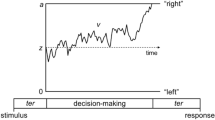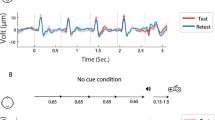Abstract
We recorded visual event-related brain potentials from 32 adult male participants (16 high-functioning participants diagnosed with autism spectrum disorder (ASD) and 16 control participants, ranging in age from 18 to 53 years) during a three-stimulus oddball paradigm. Target and non-target stimulus probability was varied across three probability conditions, whereas the probability of a third non-target stimulus was held constant in all conditions. P3 amplitude to target stimuli was more sensitive to probability in ASD than in typically developing participants, whereas P3 amplitude to non-target stimuli was less responsive to probability in ASD participants. This suggests that neural responses to changes in event probability are attention-dependant in high-functioning ASD. The implications of these findings for higher-level behaviors such as prediction and planning are discussed.






Similar content being viewed by others
References
American Psychiatric Association. (2000). Diagnostic and statistical manual of mental disorders, fourth edition, text revision. Washington, DC: American Psychiatric Association.
Bar, M. (2009). The proactive brain: Memory for predictions. Philosophical Transactions of the Royal Society B-Biological Sciences, 364(1521), 1235–1243. doi:10.1098/rstb.2008.0310.
Ceponiene, R., Lepisto, T., Shestakova, A., Vanhala, R., Alku, P., Näätänen, R., et al. (2003). Speech-sound-selective auditory impairment in children with infantile autism: They can perceive but do not attend. Proceedings of the National Academy of Sciences, 100, 5567–5572. doi:10.1073/pnas.0835631100.
Comerchero, M. D., & Polich, J. (1999). P3a and P3b from typical auditory and visual stimuli. Clinical Neurophysiology, 110(1), 24–30. doi:10.1016/S0168-5597(98)00033-1.
Courchesne, E. (1978). Changes in P3 waves with event repetition: Long-term effects on scalp distribution and amplitude. Electroencephalography and Clinical Neurophysiology, 45(6), 754–766. doi:10.1016/0013-4694(78)90143-8.
Courchesne, E., Akshoomoff, N., & Townsend, J. (1990). Recent advances in autism. Current Opinion in Pediatrics, 2, 685–693, Retrieved from http://journals.lww.com/co-pediatrics/.
Courchesne, E., Courchesne, R. Y., & Hillyard, S. A. (1978). The effect of stimulus deviation on P3 waves to easily recognized stimuli. Neuropsychologia, 16(2), 189–199. doi:10.1016/0028-3932(78)90106-9.
Courchesne, E., Hillyard, S. A., & Galambos, R. (1975). Stimulus novelty, task relevance and the visual evoked potential in man. Electroencephalography and Clinical Neurophysiology, 39(2), 131–143. doi:10.1016/0013-4694(75)90003-6.
Courchesne, E., Lincoln, A. J., Kilman, B. A., & Galambos, R. (1985). Event-related brain potential correlates of the processing of novel visual and auditory information in autism. Journal of Autism and Developmental Disorders, 15(1), 55–76. doi:10.1007/BF01837899.
Delorme, A., & Makeig, S. (2004). EEGLAB: An open source toolbox for analysis of single-trial EEG dynamics including independent component analysis. Journal of Neuroscience Methods, 134, 9–21. doi:10.1016/j.jneumeth.2003.10.009.
Donchin, E., Ritter, W., & McCallum, W. C. (Eds.). (1978). Cognitive psychophysiology: The endogenous components of the ERP (Event-related brain potentials in man). New York: Academic Press.
Dustman, R. E., Emmerson, R. Y., & Shearer, D. E. (1996). Life span changes in electrophysiological measures of inhibition. Brain and Cognition, 30(1), 109–126. doi:10.1006/brcg.1996.0007.
Gomot, M., & Wicker, B. (2012). A challenging, unpredictable world for people with autism spectrum disorder. International Journal of Psychophysiology, 83(2), 240–247. doi:10.1016/j.ijpsycho.2011.09.017.
Green, D., Charman, T., Pickles, A., Chandler, S., Loucas, T., Simonoff, E., et al. (2009). Impairment in movement skills of children with autistic spectrum disorders. Developmental Medicine and Child Neurolology,. doi:10.1111/j.1469-8749.2008.03242.x.
Harris, N., Courchesne, E., Townsend, J., Carper, R. A., & Lord, C. (1999). Neuroanatomic contributions to slowed orienting of attention in children with autism. Cognitive Brain Research, 8, 61–71. doi:10.1016/S0926-6410(99)00006-3.
Hill, E. L. (2004). Executive dysfunction in autism. Trends in Cognitive Sciences, 8(1), 26–32. doi:10.1016/j.tics.2003.11.003.
Hoeksma, M. R., Kemner, C., Kenemans, J. L., & van Engeland, H. (2006). Abnormal selective attention normalizes P3 amplitudes in PDD. Journal of Autism and Developmental Disorders, 36(5), 643–654. doi:10.1007/s10803-006-0102-5.
Hoeksma, M. R., Kemner, C., Verbaten, M. N., & van Engeland, H. (2004). Processing capacity in children and adolescents with pervasive developmental disorders. Journal of Autism and Developmental Disorders, 34(3), 341–354, Retrieved from http://www.springer.com/psychology/child+%26+school+psychology/journal/10803.
Johnson, R, Jr, & Donchin, E. (1980). P300 and stimulus categorization: Two plus one is not so different from one plus one. Psychophysiology, 17(2), 167–178. doi:10.1111/j.1469-8986.1980.tb00131.x.
Jung, T.-P., Makeig, S., Humphries, C., Lee, T. W., McKeown, M. J., Iragui, V., et al. (2000a). Removing electroencephalographic artifacts by blind source separation. Psychophysiology, 37, 163–178. doi:10.1111/1469-8986.3720163.
Jung, T.-P., Makeig, S., Westerfield, M., Townsend, J., Courchesne, E., & Sejnowski, T. J. (2000b). Removal of eye activity artifacts from visual event-related potentials in normal and clinical subjects. Clinical Neurophysiology, 111(10), 1745–1758. doi:10.1016/S1388-2457(00)00386-2.
Katayama, J., & Polich, J. (1996). P300, probability, and the three-tone paradigm. Electroencephalography and Clinical Neurophysiology, 100(6), 555–562. doi:10.1016/S0168-5597(96)95171-0.
Kemner, C., Verbaten, M. N., Cuperus, J. M., Camfferman, G., & van Engeland, H. (1995). Auditory event-related brain potentials in autistic children and three different control groups. Biological Psychiatry, 38(3), 150–165. doi:10.1016/0006-3223(94)00247-Z.
Larson, M. J., South, M., Krauskopf, E., Clawson, A., & Crowley, M. J. (2011). Feedback and reward processing in high-functioning autism. Psychiatry Research, 187(1–2), 198–203. doi:10.1016/j.psychres.2010.11.006.
Lincoln, A. J., Courchesne, E., Harms, L., & Allen, M. (1993). Contextual probability evaluation in autistic, receptive developmental language disorder, and control children: Event-related brain potential evidence. Journal of Autism and Developmental Disorders, 23(1), 37–58. doi:10.1007/BF01066417.
Lord, C., Rutter, M., DiLavore, P. C., & Risi, S. (2001). Autism diagnostic observation schedule. Los Angeles: Western Psychological Services.
Lord, C., Rutter, M., & Le Couteur, A. (1994). Autism diagnostic interview-revised: A revised version of a diagnostic interview for caregivers of individuals with possible pervasive developmental disorders. Journal of Autism and Developmental Disorders, 24(5), 659–685, Retrieved from http://www.springer.com/psychology/child+%26+school+psychology/journal/10803.
Luck, S. J. (2005). An introduction to the event-related potential technique (cognitive neuroscience). Cambridge: MIT Press.
Ming, X., Brimacombe, M., & Wagner, G. C. (2007). Prevalence of motor impairment in autism spectrum disorders. Brain Development, 29(9), 565–570. doi:10.1016/j.braindev.2007.03.002.
Novick, B., Kurtzberg, D., & Vaughn, H. G, Jr. (1979). An electrophysiological indication of defective information storage in childhood autism. Psychiatry Research, 1, 101–108. doi:10.1016/0165-1781(79)90034-9.
Oades, R. D., Walker, M. K., Geffen, L. B., & Stern, L. M. (1988). Event-related potentials in autistic and healthy children on an auditory choice reaction time task. International Journal of Psychophysiology, 6, 25–37. doi:10.1016/0167-8760(88)90032-3.
Pasupathy, A., & Miller, E. K. (2005). Different time courses of learning-related activity in the prefrontal cortex and striatum. Nature, 433(7028), 873–876. doi:10.1038/nature03287.
Polich, J. (2007). Updating P300: An integrative theory of P3a and P3b. Clinical Neurophysiology, 118(10), 2128–2148. doi:10.1016/j.clinph.2007.04.019.
Polich, J., & Comerchero, M. D. (2003). P3a from visual stimuli: Typicality, task, and topography. Brain Topography, 15(3), 141–152. doi:10.1023/A:1022637732495.
Pritchard, W. S., Raz, N., & August, G. J. (1987). Visual augmenting/reducing and P300 in autistic children. Journal of Autism and Developmental Disorders, 17(2), 231–242. doi:10.1007/BF01495058.
Rogers, S. J., & Ozonoff, S. (2005). Annotation: What do we know about sensory dysfunction in autism? A critical review of the empirical evidence. Journal of Child Psychology and Psychiatry, 46(12), 1255–1268. doi:10.1111/j.1469-7610.2005.01431.x.
Sokhadze, E. M., Baruth, J. M., Sears, L., Sokhadze, G. E., El-Baz, A. S., Williams, E., et al. (2012). Event-related potential study of attention regulation during illusory figure categorization task in Adhd, autism spectrum disorder, and typical children. Journal of Neurotherapy, 16(1), 12–31. doi:10.1080/10874208.2012.650119.
Sokhadze, E. M., Baruth, J., Tasman, A., Sears, L., Mathai, G., El-Baz, A., et al. (2009). Event-related potential study of novelty processing abnormalities in autism. Applied Psychophysiology and Biofeedback, 34(1), 37–51. doi:10.1007/s10484-009-9074-5.
Squires, K. C., Donchin, E., Herning, R. I., & McCarthy, G. (1977). On the influence of task relevance and stimulus probability on event-related-potential components. Electroencephalography and Clinical Neurophysiology, 42(1), 1–14. doi:10.1016/0013-4694(77)90146-8.
Thomas, D. G., Grice, J. W., Najm-Briscoe, R. G., & Miller, J. W. (2004). The influence of unequal numbers of trials on comparisons of average event-related potentials. Developmental Neuropsychology, 26(3), 753–774. doi:10.1207/s15326942dn2603_6.
Townsend, J., Courchesne, E., Covington, J., Westerfield, M., Harris, N. S., Lyden, P., et al. (1999). Spatial attention deficits in patients with acquired or developmental cerebellar abnormality. Journal of Neuroscience, 19(13), 5632–5643, Retrieved from http://www.jneurosci.org/.
Townsend, J., Courchesne, E., & Egaas, B. (1996). Slowed orienting of covert visual-spatial attention in autism: Specific deficits associated with cerebellar and parietal abnormality. Development and Psychopathology, 8(3), 503–584. doi:10.1017/S0954579400007276.
Townsend, J., Keehn, B., & Westerfield, M. (2011). Abstraction of mind: Attention in autism. In M. Posner (Ed.), Cognitive neuroscience of attention (pp. 357–373). New York: Guilford Press.
Townsend, J., Westerfield, M., Leaver, E., Makeig, S., Jung, T.-P., Pierce, K., et al. (2001). Event-related brain response abnormalities in autism: Evidence for impaired cerebello-frontal spatial attention networks. Cognitive Brain Research, 11(1), 127–145. doi:10.1016/S0926-6410(00)00072-0.
Verbaten, M. N., Roelofs, J. W., Van Engeland, H., & Kenemans, J. K. (1991). Abnormal visual event-related potentials of autistic children. Journal of Autism and Developmental Disorders, 21(4), 449–470. doi:10.1007/BF02206870.
Author information
Authors and Affiliations
Corresponding author
Rights and permissions
About this article
Cite this article
Westerfield, M.A., Zinni, M., Vo, K. et al. Tracking the Sensory Environment: An ERP Study of Probability and Context Updating in ASD. J Autism Dev Disord 45, 600–611 (2015). https://doi.org/10.1007/s10803-014-2045-6
Published:
Issue Date:
DOI: https://doi.org/10.1007/s10803-014-2045-6




